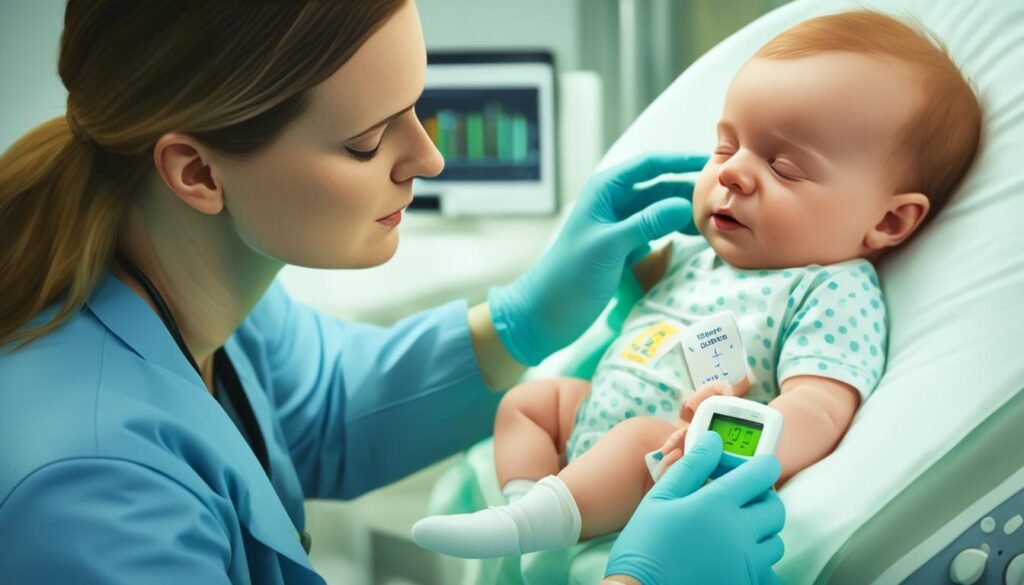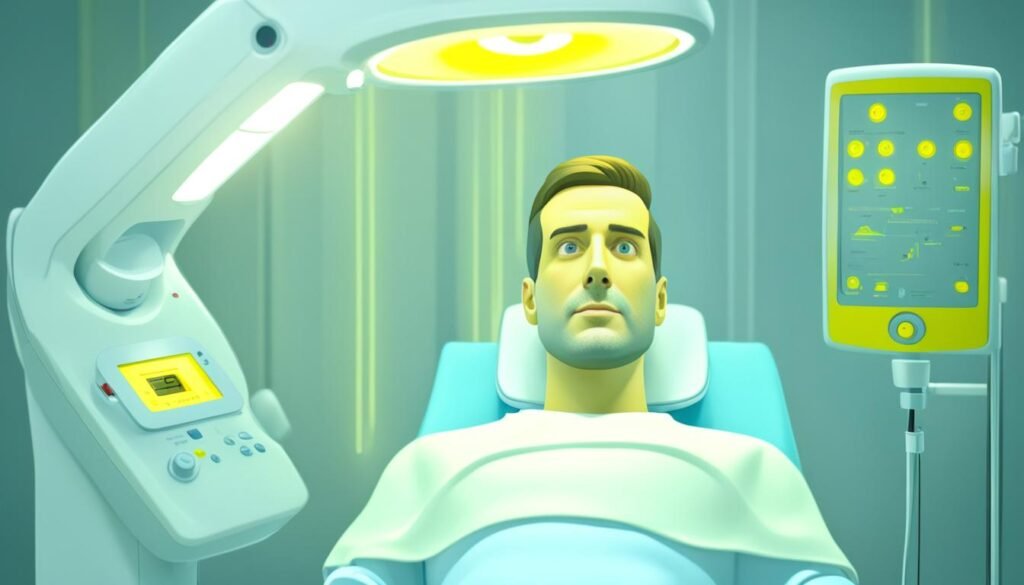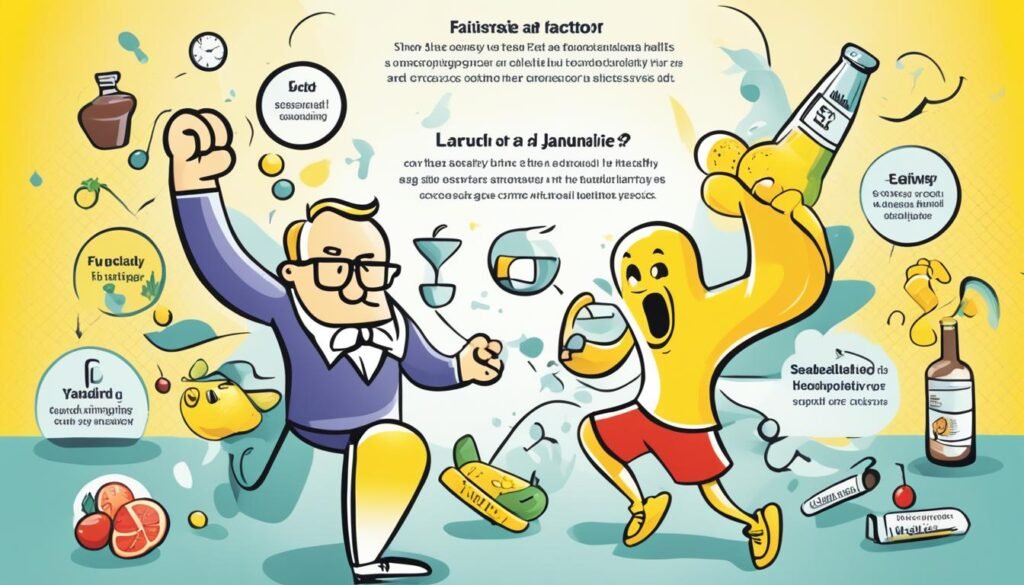Jaundice is common, especially in newborns. It makes the skin and eyes look yellow. This happens because of too much in the blood.
Table of Contents
ToggleThis guide will show you how to treat jaundice effectively. You’ll learn about the best ways to lower levels. Also, you’ll discover the different causes of jaundice.
By knowing the diagnosis and treatments available, you can help yourself or your baby get better. It’s your chance to learn and play a role in getting to vibrant health.
Understanding Jaundice
Jaundice makes the skin and eyes yellow. It’s caused by too much bilirubin in the blood. Bilirubin is a yellow-orange waste from old red blood cells. Usually, the liver filters out this waste. But if there’s too much bilirubin or the liver doesn’t work right, jaundice happens.
What is Jaundice?
Jaundice turns the skin and eyes yellow. It happens because of too much bilirubin. Your body makes bilirubin when it breaks down old red blood cells. Normally, the liver takes care of bilirubin. But if there’s a lot or the liver doesn’t work properly, you get jaundice.
Causes of Jaundice
Jaundice can happen for many reasons. Some of these include liver inflammation, alcohol liver disease, and blocked bile ducts. Pancreatic cancer, some meds, blood clots, and certain anemias can also cause it. In adults, hepatitis and alcohol liver diseases are common causes. So are autoimmune and genetic liver problems. Certain medications, like acetaminophen and steroids, can also lead to jaundice.
Types of Jaundice
There are different types of jaundice. Neonatal jaundice affects newborns. Hemolytic jaundice, obstructive jaundice, and hepatocellular jaundice have different causes. Knowing the type is important for treating and getting better from jaundice.

Diagnosing Jaundice in Newborns
Diagnosing jaundice in newborns is key for good care. Doctors check babies by using a physical exam, blood tests, and special tools. They look for how severe it is and figure out why it’s happening. Understand What Is Jaundice In Babies?
Physical Examination
The first thing doctors do is a full exam. They look for jaundice within 72 hours of birth. They check the skin and eyes for a yellow color, a sign of jaundice. They might also look at the baby’s gums, urine, and poop colors.
Blood Tests
Doctors might order a blood test to be sure about jaundice. This is needed if jaundice shows up fast or seems really bad. The test tells exactly how much bilirubin is in the blood. It helps plan the best treatment.
Transcutaneous Bilirubinometer
Doctors use a transcutaneous bilirubinometer sometimes. This device checks the baby’s skin for bilirubin. It’s quick and doesn’t need a blood test.

Jaundice Treatment
Treating jaundice depends on why it occurred and how bad it is. For mild jaundice, it often goes away in two to three weeks without treatment. But, if it’s more serious, the doctor might suggest different ways to lower the baby’s bilirubin levels.
Enhanced Nutrition
Getting the right food is key to fighting jaundice. Newborns who are breastfed need to eat a lot, about 8 to 12 times a day at the start. This helps their bowels work and gets rid of bilirubin. Babies who drink formula should have 1 to 2 ounces every few hours for the first week. This makes sure they’re getting enough and helps get rid of bilirubin from their system.
Light Therapy (Phototherapy)
Phototherapy uses a special light to treat newborn jaundice. When a baby’s skin is exposed to blue light, it breaks down the bilirubin in their blood. This method is very good at lowering bilirubin levels and making jaundice better in babies.
Intravenous Immunoglobulin (IVIg)
For some types of jaundice, giving a baby intravenous immunoglobulin (IVIg) can help. This treatment targets the extra antibodies causing the problem. It works well for babies with hemolytic jaundice, a kind of jaundice where the baby’s immune system is too active.
Exchange Transfusion
In very bad cases of jaundice, doctors might do an exchange transfusion. This procedure is rare and is only used when other treatments haven’t worked. It involves taking out the baby’s blood bit by bit and replacing it with clean donor blood. This quickly lowers bilirubin levels and can stop severe jaundice from getting worse.

Self-Care for Infant Jaundice
For mild infant jaundice, self-care helps lower bilirubin levels. Your doctor might suggest more feedings and extra feeds.
More Frequent Feedings
During the first days, breastfed babies need 8 to 12 feedings. This helps remove extra bilirubin. For formula-fed babies, 1 to 2 ounces every 2 to 3 hours is good for the first week.
Feeding more often helps your baby pass bilirubin in their stool. This lowers the jaundice level.
Supplemental Feedings
If needed, your doctor might say to add more feeds for better nutrition and bilirubin removal. You could give expressed milk or formula along with breastfeeding. Supplemental feeding is good if your baby isn’t eating much or if you can’t breastfeed often.
Using these tips can help manage your baby’s jaundice and support their health. Always check how your baby is doing and talk to your doctor if you have any concerns.

Preparing for a Doctor’s Appointment
When your baby leaves the hospital, a doctor or nurse might look for jaundice signs. They check how likely severe jaundice is. They look at the baby’s blood bilirubin level, birth timing, feeding, age, delivery bruising, and family jaundice history.
The follow-up visits focus on your baby’s eating, wet diapers, poop, and how well they are. The doctor might ask about jaundice level, treatments, hospital needs, and next visits.
Getting ready for these check-ups means noting down how your baby eats, poops, and other details. If you’re finding it hard to breastfeed, reach out to a specialist. Call the doctor right away if jaundice or symptoms like tiredness, lost weight, or watery poop last more than 2 to 3 weeks.
Treating Jaundice in Adults
Jaundice mostly affects newborns, but adults can get it too. Treating adult jaundice means tackling the main issue, like liver disease or a bile duct problem. Doctors might treat viral infections or check for pancreas issues.
Addressing Underlying Conditions
If a health problem is causing jaundice, the treatment is about fixing that issue first. Treatments differ based on what’s causing the jaundice. This could mean taking medicine, making lifestyle changes, or having surgery.
Take a blocked bile duct for instance. To fix it, a procedure might be needed to make bile flow well again. If liver disease is behind the jaundice, treatment could include meds, new diet rules, or a possible transplant.
Cholestyramine for Itching
Jaundice in adults often leads to severe itching. To deal with this, your doctor might suggest using cholestyrmine. This drug binds to bile salts in the intestines, which helps with the itching.
Other treatments for itching can include special creams or antihistamines. It’s also good to drink lots of water and use gentle skincare that’s free from fragrances.

Risk Factors and Prevention
Jaundice is more common among newborns, but adults can also get it. Many factors can lead to jaundice in adults.
Risk Factors for Jaundice in Adults
The main risk factors for adult jaundice are:
- Having liver diseases like cirrhosis or hepatitis
- Problems with the gallbladder or bile ducts
- Using certain medications that harm the liver
- Drinking too much alcohol
- Health issues affecting how the body breaks down or makes red blood cells
Lifestyle Changes to Reduce Risk
To lower your adult jaundice risk, try these lifestyle tweaks:
- Eat well and skip overdoing alcohol
- Stay hydrated by drinking a lot of water
- Avoid toxins and liver-harming chemicals
- Keep any health issues that can lead to jaundice in check
- Talk to your doctor about medicines that might up your jaundice odds

and making
lifestyle changes to reduce jaundice risk
, you can take proactive steps to prevent or manage this condition effectively.
Jaundice and Liver Disease
Jaundice links often to liver diseases. The liver helps process and get rid of bilirubin. Bilirubin is a yellow-orange pigment. It builds up in the blood, making the skin and eyes look yellow. Adults may get jaundice from conditions like hepatitis, problems from drinking too much alcohol, and blocked bile ducts.
Hepatitis makes the liver swell. It can be short-term (acute) or long-term (chronic). Alcohol liver diseases, like alcoholic hepatitis and cirrhosis, happen after many years of heavy drinking, usually 8 to 10 years. Also, pancreatic cancer can block the bile ducts, leading to jaundice.
Some drugs, such as acetaminophen, penicillin, birth control pills, and steroids, might also cause liver problems and jaundice. If you have jaundice, working closely with healthcare providers is key. They’ll help figure out the cause, which might need different treatments depending on what it is.
Complications of Untreated Jaundice
Jaundice is quite common, especially in newborns. It’s vital to treat it to avoid serious risks from high bilirubin. Left untreated, jaundice can lead to kernicterus, a type of brain damage.
Kernicterus in Newborns
Kernicterus is a rare but serious consequence of untreated jaundice. It happens when excessive bilirubin reaches the brain due to high levels in the blood. This can lead to serious issues like movement problems, hearing loss, and brain damage.
Early diagnosis and treatment are key to preventing kernicterus and other risks. Doctors must watch for jaundice signs and act to keep bilirubin levels safe. This shows how important it is to deal with jaundice early, for both parents and medical teams, to save newborns from its worst outcomes.
Phototherapy: Treating Jaundice with Light
Phototherapy is a well-known way to treat newborn jaundice. It uses a specific light that helps the baby’s body lower bilirubin. This is used when jaundice is serious or when it stays or gets worse.
For phototherapy for treating jaundice with light, babies lie under special lights. These can be blue, white, or LED. The light helps change the bilirubin in a way that the body can easily remove it. Babies stay under these lights for hours and their bilirubin levels are checked every few hours.
The baby’s bilirubin levels often get better within 6 to 12 hours of starting phototherapy for jaundice. It’s a very good treatment with few side effects. It’s usually tried first for babies with high bilirubin.
If phototherapy for jaundice doesn’t work or if bilirubin goes higher, a blood exchange might be needed. This quickly lowers the bilirubin levels. The baby might also need fluids if they get dehydrated during treatment.
Overall, phototherapy for jaundice is safe and helpful for babies with high bilirubin. It’s good for parents to know about this treatment. They can better care for their baby’s health by being informed.
Exchange Transfusion for Severe Jaundice
If your baby’s high bilirubin levels do not get better with phototherapy or better feeding, a special procedure might be needed. This procedure is called an exchange transfusion. It swaps some of your baby’s blood with healthy donor blood. This helps to quickly get rid of the extra bilirubin in the blood.
Recent figures show that around 4.9% of very jaundiced babies needed an exchange transfusion. Most of these babies (90.2%) were delivered in a hospital. Also, about 95% of their mothers had regular checkups before giving birth. Nearly 76.3% had faced troubles in earlier pregnancies.
The top reason for an exchange transfusion was Rh incompatibility, making up 80.5% of cases. In 58.5% of these babies, the Coombs test was positive. This test looks for antibodies that attack red blood cells. Before the procedure, the babies’ bilirubin levels averaged 9.44 mg/dL. But after the exchange transfusion, it dropped to an average of 4.41 mg/dL.
FAQ
What is jaundice?
What causes jaundice?
How is jaundice diagnosed in newborns?
What are the treatment options for jaundice?
How can I manage mild infant jaundice at home?
How can adults develop jaundice?
What are the potential complications of untreated jaundice?
How does phototherapy work to treat jaundice?
When is exchange transfusion necessary for severe jaundice?
Source Links
- https://www.webmd.com/hepatitis/jaundice-why-happens-adults
- https://www.nhs.uk/conditions/jaundice-newborn/treatment/
- https://www.mayoclinic.org/diseases-conditions/infant-jaundice/diagnosis-treatment/drc-20373870
- https://www.nhs.uk/conditions/jaundice-newborn/diagnosis/
- https://myhealth.alberta.ca/Health/aftercareinformation/pages/conditions.aspx?hwid=uh4439
- https://my.clevelandclinic.org/health/diseases/22263-jaundice-in-newborns
- https://www.mountsinai.org/health-library/discharge-instructions/newborn-jaundice-discharge
- https://www.healthdirect.gov.au/jaundice
- https://www.mayoclinic.org/diseases-conditions/infant-jaundice/symptoms-causes/syc-20373865
- https://www.arfaalawgroup.com/untreated-jaundice-complications.html
- https://www.ncbi.nlm.nih.gov/pmc/articles/PMC8286359/


